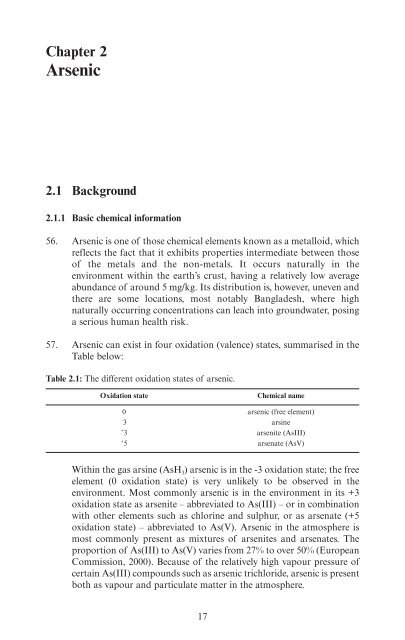Guidelines for Metals and Metalloids in Ambient ... - ARCHIVE: Defra
Guidelines for Metals and Metalloids in Ambient ... - ARCHIVE: Defra
Guidelines for Metals and Metalloids in Ambient ... - ARCHIVE: Defra
You also want an ePaper? Increase the reach of your titles
YUMPU automatically turns print PDFs into web optimized ePapers that Google loves.
Chapter 2<br />
Arsenic<br />
2.1 Background<br />
2.1.1 Basic chemical <strong>in</strong><strong>for</strong>mation<br />
56. Arsenic is one of those chemical elements known as a metalloid, which<br />
reflects the fact that it exhibits properties <strong>in</strong>termediate between those<br />
of the metals <strong>and</strong> the non-metals. It occurs naturally <strong>in</strong> the<br />
environment with<strong>in</strong> the earth’s crust, hav<strong>in</strong>g a relatively low average<br />
abundance of around 5 mg/kg. Its distribution is, however, uneven <strong>and</strong><br />
there are some locations, most notably Bangladesh, where high<br />
naturally occurr<strong>in</strong>g concentrations can leach <strong>in</strong>to groundwater, pos<strong>in</strong>g<br />
a serious human health risk.<br />
57. Arsenic can exist <strong>in</strong> four oxidation (valence) states, summarised <strong>in</strong> the<br />
Table below:<br />
Table 2.1: The different oxidation states of arsenic.<br />
Oxidation state<br />
0<br />
-<br />
3<br />
+<br />
3<br />
+<br />
5<br />
Chemical name<br />
arsenic (free element)<br />
ars<strong>in</strong>e<br />
arsenite (AsIII)<br />
arsenate (AsV)<br />
With<strong>in</strong> the gas ars<strong>in</strong>e (AsH 3 ) arsenic is <strong>in</strong> the -3 oxidation state; the free<br />
element (0 oxidation state) is very unlikely to be observed <strong>in</strong> the<br />
environment. Most commonly arsenic is <strong>in</strong> the environment <strong>in</strong> its +3<br />
oxidation state as arsenite – abbreviated to As(III) – or <strong>in</strong> comb<strong>in</strong>ation<br />
with other elements such as chlor<strong>in</strong>e <strong>and</strong> sulphur, or as arsenate (+5<br />
oxidation state) – abbreviated to As(V). Arsenic <strong>in</strong> the atmosphere is<br />
most commonly present as mixtures of arsenites <strong>and</strong> arsenates. The<br />
proportion of As(III) to As(V) varies from 27% to over 50% (European<br />
Commission, 2000). Because of the relatively high vapour pressure of<br />
certa<strong>in</strong> As(III) compounds such as arsenic trichloride, arsenic is present<br />
both as vapour <strong>and</strong> particulate matter <strong>in</strong> the atmosphere.<br />
17
















